

Compact Muon Solenoid
LHC, CERN
| CMS-SUS-21-007 ; CERN-EP-2022-169 | ||
| Search for supersymmetry in final states with a single electron or muon using angular correlations and heavy-object identification in proton-proton collisions at $ \sqrt{s}= $ 13 TeV | ||
| CMS Collaboration | ||
| 15 November 2022 | ||
| JHEP 09 (2023) 149 | ||
| Abstract: A search for supersymmetry is presented in events with a single charged lepton, electron or muon, and multiple hadronic jets. The data correspond to an integrated luminosity of 138 fb$ ^{-1} $ of proton-proton collisions at a center-of-mass energy of 13 TeV, recorded by the CMS experiment at the CERN LHC. The search targets gluino pair production, where the gluinos decay into final states with the lightest supersymmetric particle (LSP) and either a top quark-antiquark ( $ \mathrm{t} \overline{\mathrm{t}} $) pair, or a light-flavor quark-antiquark ($ \mathrm{q}\overline{\mathrm{q}} $) pair and a virtual or on-shell W boson. The main backgrounds, $ \mathrm{t} \overline{\mathrm{t}} $ pair and W+jets production, are suppressed by requirements on the azimuthal angle between the momenta of the lepton and of its reconstructed parent W boson candidate, and by top quark and W boson identification based on a machine-learning technique. The number of observed events is consistent with the expectations from standard model processes. Limits are evaluated on supersymmetric particle masses in the context of two simplified models of gluino pair production. Exclusions for gluino masses reach up to 2120 (2050) GeV at 95% confidence level for a model with gluino decay to a $ \mathrm{t} \overline{\mathrm{t}} $ pair (a $ \mathrm{q}\overline{\mathrm{q}} $ pair and a W boson) and the LSP. For the same models, limits on the mass of the LSP reach up to 1250 (1070) GeV. | ||
| Links: e-print arXiv:2211.08476 [hep-ex] (PDF) ; CDS record ; inSPIRE record ; HepData record ; CADI line (restricted) ; | ||
| Figures | |

png pdf |
Figure 1:
Diagrams showing the simplified SUSY models T1tttt (left) and T5qqqqWW (right). |
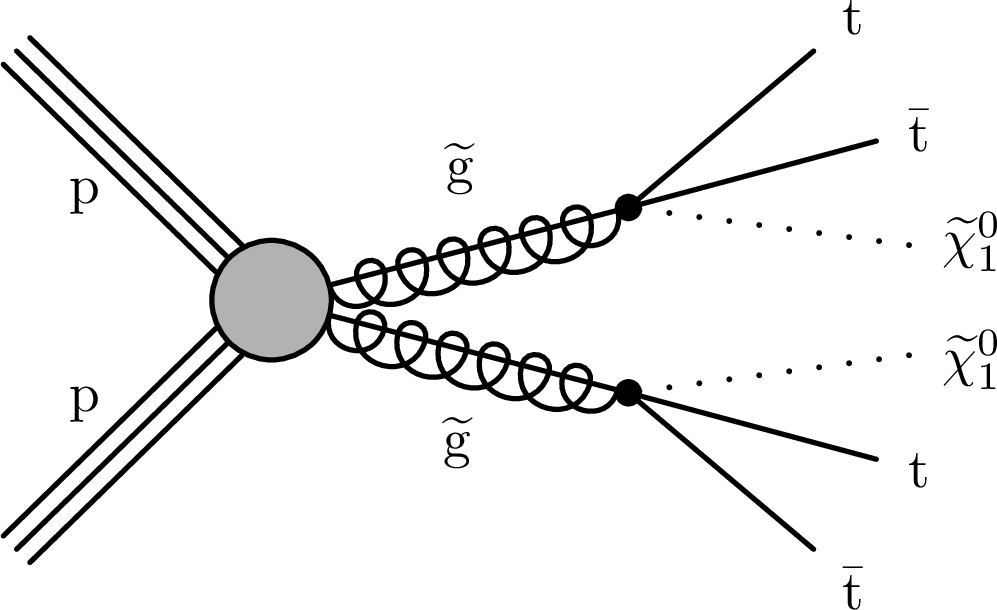
png pdf |
Figure 1-a:
Diagram showing the T1tttt simplified SUSY model. |

png pdf |
Figure 1-b:
Diagram showing the T5qqqqWW simplified SUSY model. |
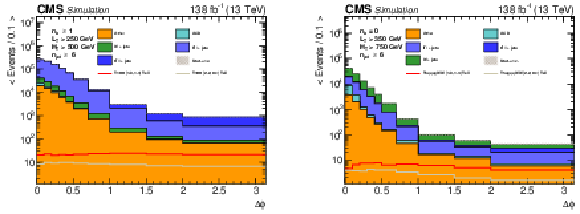
png pdf |
Figure 2:
Signal and background distributions of the $ \Delta\phi $ variable, as predicted by simulation, for the multi-b analysis, requiring $ n_{\text{jet}}\geq $ 6, $ L_{\mathrm{T}} > $ 250 GeV, $ H_{\mathrm{T}} > $ 500 GeV (left), and the zero-b analysis, requiring $ n_{\text{jet}}\geq $ 6, $ L_{\mathrm{T}} > $ 350 GeV, $ H_{\mathrm{T}} > $ 750 GeV (right). The predicted signal distributions are also shown for two representative combinations of (gluino, neutralino) masses with large (2.2, 0.1) TeV and small (1.8, 1.3) TeV mass differences. |

png pdf |
Figure 2-a:
Signal and background distributions of the $ \Delta\phi $ variable, as predicted by simulation, for the multi-b analysis, requiring $ n_{\text{jet}}\geq $ 6, $ L_{\mathrm{T}} > $ 250 GeV, $ H_{\mathrm{T}} > $ 500 GeV. The predicted signal distributions are also shown for two representative combinations of (gluino, neutralino) masses with large (2.2, 0.1) TeV and small (1.8, 1.3) TeV mass differences. |

png pdf |
Figure 2-b:
Signal and background distributions of the $ \Delta\phi $ variable, as predicted by simulation, for the zero-b analysis, requiring $ n_{\text{jet}}\geq $ 6, $ L_{\mathrm{T}} > $ 350 GeV, $ H_{\mathrm{T}} > $ 750 GeV. The predicted signal distributions are also shown for two representative combinations of (gluino, neutralino) masses with large (2.2, 0.1) TeV and small (1.8, 1.3) TeV mass differences. |

png pdf |
Figure 3:
Distributions of $ \Delta\phi $ as obtained from simulation, requiring various t tag multiplicities for the total background (left) and for the signal in two representative combinations of (gluino, neutralino) masses with large (2.2, 0.1) TeV and small (1.8, 1.3) TeV mass difference (right). |

png pdf |
Figure 3-a:
Distribution of $ \Delta\phi $ as obtained from simulation requiring various t tag multiplicities for the total background. |
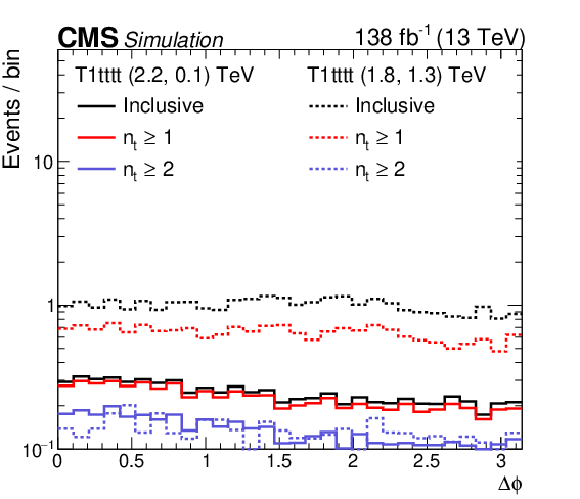
png pdf |
Figure 3-b:
Distribution of $ \Delta\phi $ as obtained from simulation for the signal in two representative combinations of (gluino, neutralino) masses with large (2.2, 0.1) TeV and small (1.8, 1.3) TeV mass difference. |

png pdf |
Figure 4:
Overview of the regions used to calculate $ R^{\mathrm{CS}} $ for the multi-b (left) and zero-b (right) analysis. For the multijet (QCD) fit, the electron (e) sample is used, while the muon ($ \mu $) sample is used for the determination of $R_{\mathrm{W}}^{\text{CS}}$. |

png pdf |
Figure 5:
Graphical presentation of the regions indexed by pairs of SB or MB and CR or SR: for the multi-b (left) and for the zero-b (middle and right) analysis. The value of $ \Delta\phi $ separating CR and SR is labeled as $ \Delta\phi_0$. It is independent of the SR bin for the multi-b analysis with a value of 0.75, but varies from 0.5 to 1 among the zero-b SR bins. |
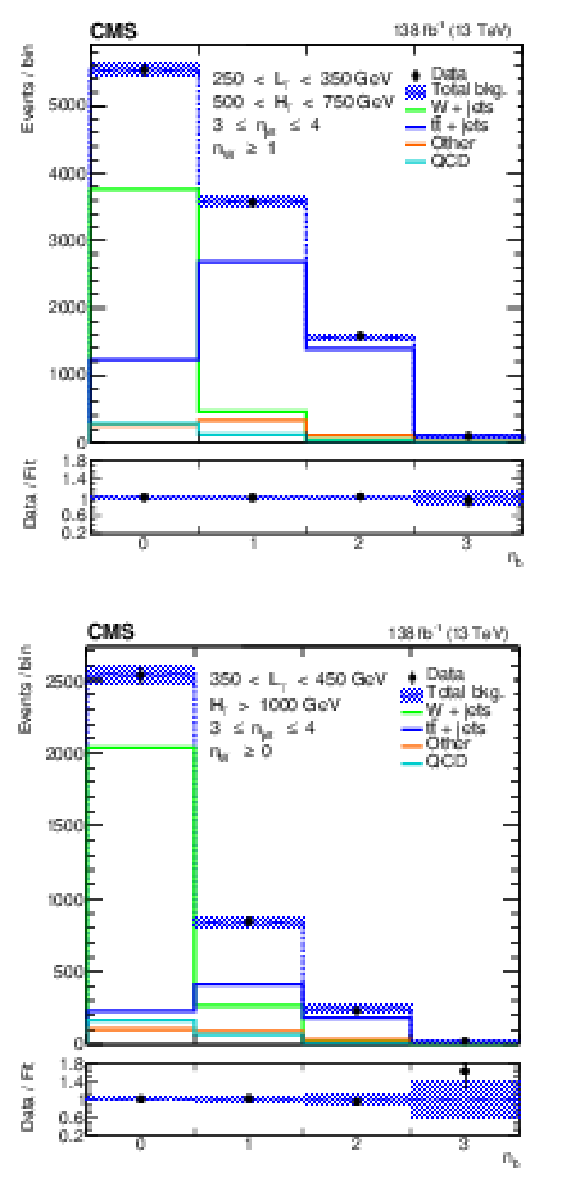
png pdf |
Figure 6:
Results of fits to the $ n_{\mathrm{b}} $ multiplicity for control regions for the muon channel and with the requirements 3 $ \leq n_{\text{jet}}\leq $ 4, 250 $ < L_{\mathrm{T}} < $ 350 GeV, 500 $ < H_{\mathrm{T}} < $ 750 GeV, $ n_{\mathrm{W}}\geq $ 1, $ \Delta\phi < $ 1 (left) and 3 $ \leq n_{\text{jet}}\leq $ 4, 350 $ < L_{\mathrm{T}} < $ 450 GeV, $ H_{\mathrm{T}} > $ 1000 GeV, $ n_{\mathrm{W}}\geq $ 0, $ \Delta\phi < $ 1 (right). The shaded area shows the fit uncertainty of the total background. |

png pdf |
Figure 6-a:
Results of fits to the $ n_{\mathrm{b}} $ multiplicity for control regions for the muon channel and with the requirements 3 $ \leq n_{\text{jet}}\leq $ 4, 250 $ < L_{\mathrm{T}} < $ 350 GeV, 500 $ < H_{\mathrm{T}} < $ 750 GeV, $ n_{\mathrm{W}}\geq $ 1, $ \Delta\phi < $ 1. The shaded area shows the fit uncertainty of the total background. |

png pdf |
Figure 6-b:
Results of fits to the $ n_{\mathrm{b}} $ multiplicity for control regions for the muon channel and with the requirements 3 $ \leq n_{\text{jet}}\leq $ 4, 350 $ < L_{\mathrm{T}} < $ 450 GeV, $ H_{\mathrm{T}} > $ 1000 GeV, $ n_{\mathrm{W}}\geq $ 0, $ \Delta\phi < $ 1. The shaded area shows the fit uncertainty of the total background. |
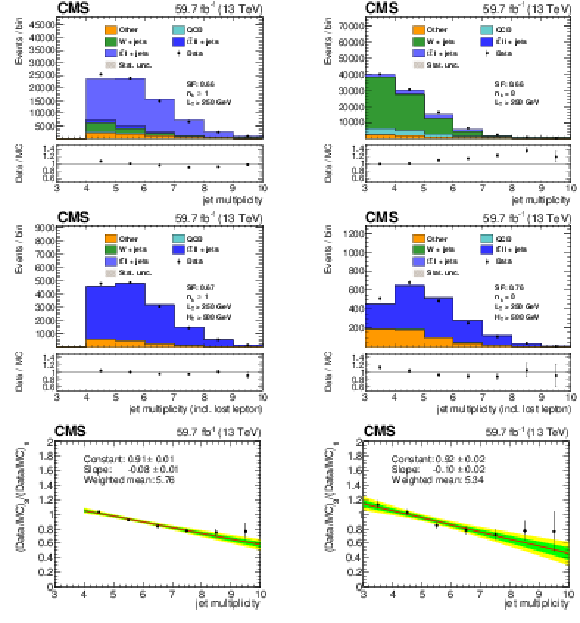
png pdf |
Figure 7:
The upper row shows the jet multiplicity distribution after the single-lepton baseline selection excluding the SRs for the multi-b analysis (left) and for the zero-b analysis (right). The middle row contains the dilepton CRs, again for the multi-b analysis (left) and for the zero-b analysis (right). The simulation is normalized to data with the SF mentioned in the plot. The double ratio of the single-lepton and dilepton ratio between data and simulation together with fit results and their uncertainties is shown in the lower row for the multi-b (left) and the zero-b (right) analysis. The fits are performed for each data-taking year; 2018 is shown as an example. |
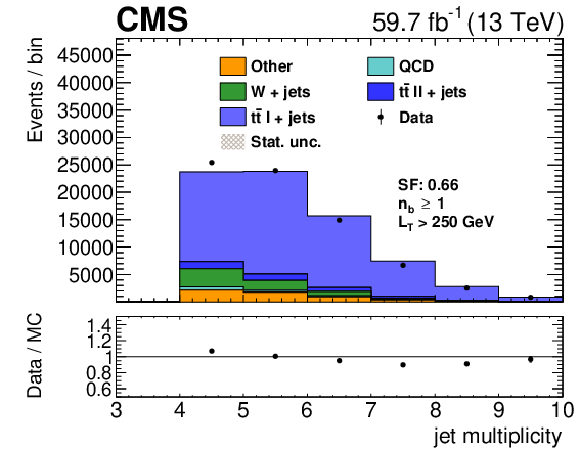
png pdf |
Figure 7-a:
Jet multiplicity distribution after the single-lepton baseline selection excluding the SRs for the multi-b analysis. The fits are performed for each data-taking year; 2018 is shown as an example. |

png pdf |
Figure 7-b:
Jet multiplicity distribution after the single-lepton baseline selection excluding the SRs for the zero-b analysis. The fits are performed for each data-taking year; 2018 is shown as an example. |

png pdf |
Figure 7-c:
Dilepton CRs for the multi-b analysis. The simulation is normalized to data with the SF mentioned in the plot. The fits are performed for each data-taking year; 2018 is shown as an example. |

png pdf |
Figure 7-d:
Dilepton CRs for the zero-b analysis. The simulation is normalized to data with the SF mentioned in the plot. The fits are performed for each data-taking year; 2018 is shown as an example. |
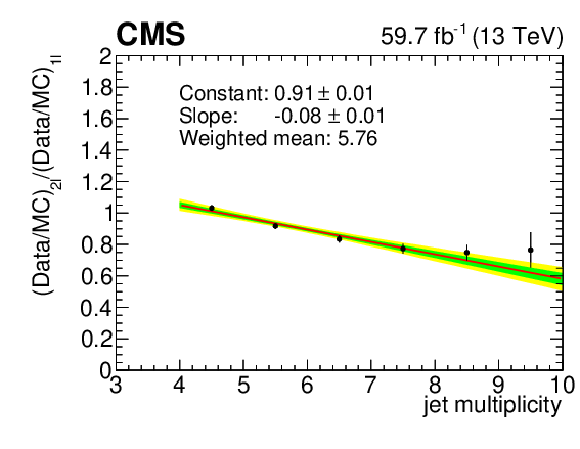
png pdf |
Figure 7-e:
Double ratio of the single-lepton and dilepton ratio between data and simulation together with fit results and their uncertainties for the multi-b analysis. The fits are performed for each data-taking year; 2018 is shown as an example. |

png pdf |
Figure 7-f:
Double ratio of the single-lepton and dilepton ratio between data and simulation together with fit results and their uncertainties for the zero-b analysis. The fits are performed for each data-taking year; 2018 is shown as an example. |
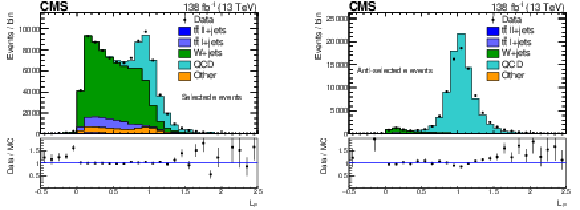
png pdf |
Figure 8:
The prefit $ L_{\mathrm{P}} $ distribution for selected (left) and anti-selected (right) electron candidates in the baseline QCD selection, with modified requirements of $ n_{\text{jet}}\in$ [3,4] and $ n_{\mathrm{b}}= $ 0. |
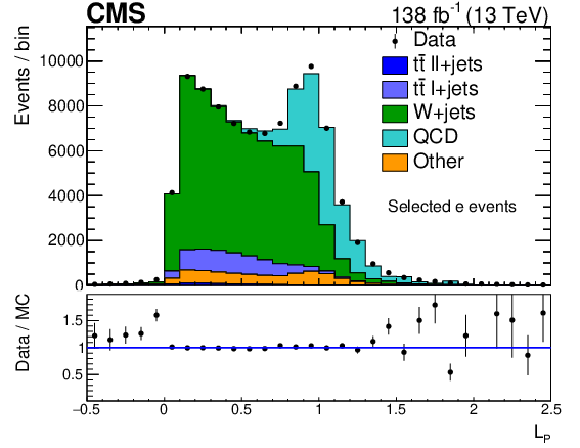
png pdf |
Figure 8-a:
The prefit $ L_{\mathrm{P}} $ distribution for selected electron candidates in the baseline QCD selection, with modified requirements of $ n_{\text{jet}}\in$ [3,4] and $ n_{\mathrm{b}}= $ 0. |
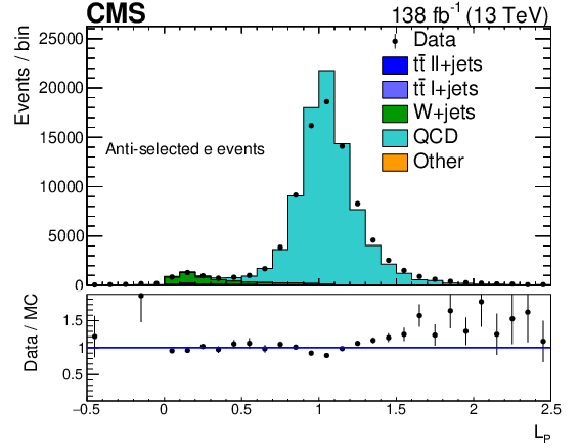
png pdf |
Figure 8-b:
The prefit $ L_{\mathrm{P}} $ distribution for anti-selected electron candidates in the baseline QCD selection, with modified requirements of $ n_{\text{jet}}\in$ [3,4] and $ n_{\mathrm{b}}= $ 0. |
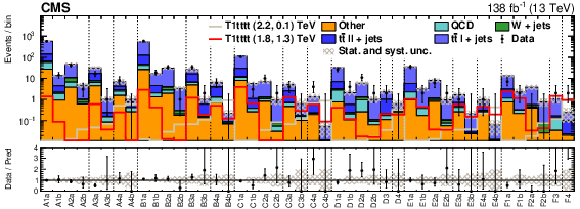
png pdf |
Figure 9:
Observed event yields in the MB SRs of the multi-b analysis compared to signal and background predictions. The relative fraction of the different SM EW background contributions determined in simulation is shown by the stacked, colored histograms, normalized so that their sum is equal to the background estimated using data control regions. The QCD background is predicted using the $ L_{\mathrm{P}} $ method. The signal is shown for two representative combinations of (gluino, neutralino) masses with large (2.2, 0.1) TeV and small (1.8, 1.3) TeV mass differences. |
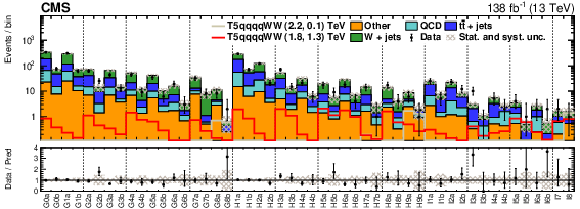
png pdf |
Figure 10:
Observed event yields in the MB SRs of the zero-b analysis compared to signal and background predictions. The W+jets, $ \mathrm{t} \overline{\mathrm{t}} $, and QCD predictions are extracted from data control samples, while the other background contributions are estimated from simulation. The signal is shown for two representative combinations of (gluino, neutralino) masses with large (2.2, 0.1) TeV and small (1.8, 1.3) TeV mass differences. |
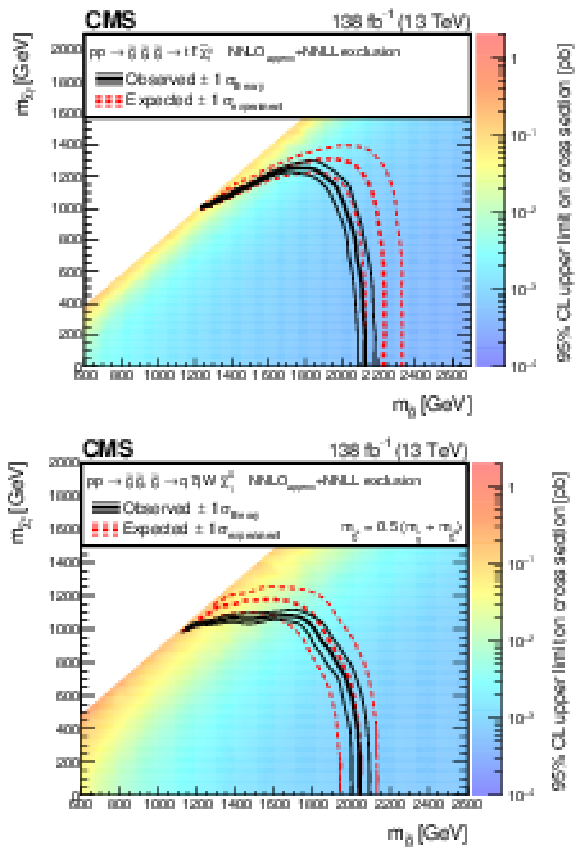
png pdf |
Figure 11:
Cross section limits at 95% CL for the T1tttt (left) and for the T5qqqqWW (right) model, as functions of the gluino and LSP masses, assuming a branching fraction of 100%. The mass of the intermediate chargino is taken to be halfway between the gluino and the neutralino masses. The solid black (dashed red) lines correspond to the observed (expected) mass limits, with the thicker lines representing the central values and the thinner lines representing the $ \pm$1$\sigma $ uncertainty bands related to the theoretical (experimental) uncertainties. |
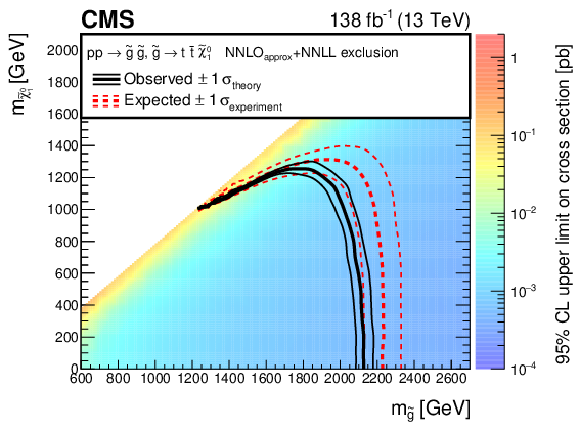
png pdf |
Figure 11-a:
Cross section limits at 95% CL for the T1tttt model, as functions of the gluino and LSP masses, assuming a branching fraction of 100%. The mass of the intermediate chargino is taken to be halfway between the gluino and the neutralino masses. The solid black (dashed red) lines correspond to the observed (expected) mass limits, with the thicker lines representing the central values and the thinner lines representing the $ \pm$1$\sigma $ uncertainty bands related to the theoretical (experimental) uncertainties. |

png pdf |
Figure 11-b:
Cross section limits at 95% CL for the T5qqqqWW model, as functions of the gluino and LSP masses, assuming a branching fraction of 100%. The mass of the intermediate chargino is taken to be halfway between the gluino and the neutralino masses. The solid black (dashed red) lines correspond to the observed (expected) mass limits, with the thicker lines representing the central values and the thinner lines representing the $ \pm$1$\sigma $ uncertainty bands related to the theoretical (experimental) uncertainties. |
| Tables | |

png pdf |
Table 1:
Baseline event selection. |

png pdf |
Table 2:
Summary of systematic uncertainties in the background prediction for the multi-b analysis. For each uncertainty source, the median, minimal (min), and maximal (max) impact on the total background prediction is shown in order of decreasing importance, where these quantities refer to the set of MB SR bins. |

png pdf |
Table 3:
Summary of systematic uncertainties in the background prediction for the zero-b analysis. For each uncertainty source, the median, minimal (min), and maximal (max) impact on the $ \mathrm{t} \overline{\mathrm{t}} $, W+jets, and total background prediction is shown in order of decreasing importance for the total background, where these quantities refer to the set of MB SR bins. |
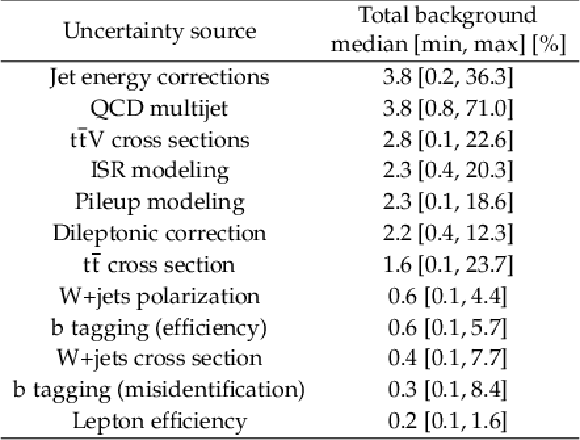
png pdf |
Table 4:
Summary of the main systematic uncertainties in the signal prediction for the multi-b analysis, for two representative combinations of (gluino, neutralino) masses with large (2.2, 0.1) TeV and small (1.8, 1.3) TeV mass differences. For each uncertainty source, the median, minimal (min), and maximal (max) impact on the total background prediction is shown in order of decreasing importance for the T1tttt(1.8, 1.3) TeV signal, where these quantities refer to the set of MB SR bins. |

png pdf |
Table 5:
Summary of the main systematic uncertainties in the signal prediction for the zero-b analysis, for two representative combinations of (gluino, neutralino) masses with large (2.2, 0.1) TeV and small (1.8, 1.3) TeV mass differences. For each uncertainty source, the median, minimal (min), and maximal (max) impact on the total background prediction is shown in order of decreasing importance for the T5qqqqWW(1.8, 1.3) TeV signal, where these quantities refer to the set of MB SR bins. |

png pdf |
Table 6:
Observed number of events in the MB SR bins of the multi-b analysis, together with the predicted yields for background and two T1tttt ($ m_{\mathrm{\widetilde{g}}} $, $ m_{\tilde{\chi}_{1}^{0}} $) signal points. All bins are defined with $ \Delta\phi > $ 0.75. |

png pdf |
Table 7:
Observed number of events in the MB SR bins of the zero-b analysis, together with the predicted yields for background and two T5qqqqWW ($ m_{\mathrm{\widetilde{g}}} $, $ m_{\tilde{\chi}_{1}^{0}} $) signal points. |
| Summary |
| A search for supersymmetry has been performed using a sample of proton-proton collisions at $ \sqrt{s}= $ 13 TeV corresponding to an integrated luminosity of 138 fb$ ^{-1} $, recorded by the CMS experiment in 2016--2018. Events with a single charged lepton (electron or muon) and multiple jets are selected. Top quark and W boson identification algorithms based on machine-learning techniques are employed to suppress the main background contributions in the analysis. Various exclusive search regions are defined that differ in the number of jets, the number of jets identified as stemming from b quarks, the number of hadronically decaying top quarks or W bosons, the scalar sum of all jet transverse momenta, and the scalar sum of the missing transverse momentum and the transverse momentum of the lepton. By targeting final states with one lepton, this analysis represents a search for SUSY complementary to those without any leptons in their final states. To reduce the main background processes from $ \mathrm{t} \overline{\mathrm{t}} $ and W+jets production, the presence of a lepton produced in the leptonic decay of a W boson in the event is exploited. Under the hypothesis that all of the missing transverse momentum in the event originates from the neutrino produced in a leptonic W boson decay, the W boson momentum is calculated. The requirement of a large azimuthal angle between the directions of the lepton and of the reconstructed W boson decaying leptonically, notably reduces the background contributions. The event yields observed in data are consistent with the expectations from the SM processes, which are estimated using control samples in data. Exclusion limits on the supersymmetric particle masses in the context of two simplified models of gluino pair production are evaluated. For the T1tttt simplified model, where each gluino decays to a top quark-antiquark pair and the lightest neutralino, the excluded gluino masses reach up to 2120 GeV, while the excluded neutralino masses reach up to 1250 GeV. This result extends the exclusion limit on gluino (neutralino) masses from a previous CMS search [19] by about 310 (150) GeV. The second simplified model, T5qqqqWW, also targets gluino pair production, but with decays to a light-flavor quark-antiquark pair and a chargino, which decays to a W boson and the lightest neutralino. The chargino mass in this decay channel is assumed to be $ m_{\tilde{\chi}_{1}^{\pm}}=$ 0.5$(m_{\mathrm{\widetilde{g}}}+m_{\tilde{\chi}_{1}^{0}}) $. The excluded gluino masses reach up to 2050 GeV, while the excluded neutralino masses reach up to 1070 GeV. This corresponds to an improvement on gluino (neutralino) masses by about 150 (120) GeV in comparison with the previous result [19]. |
| References | ||||
| 1 | J. Wess and B. Zumino | A Lagrangian model invariant under supergauge transformations | PLB 49 (1974) 52 | |
| 2 | P. Fayet and S. Ferrara | Supersymmetry | Phys. Rept. 32 (1977) 249 | |
| 3 | R. Barbieri, S. Ferrara, and C. A. Savoy | Gauge models with spontaneously broken local supersymmetry | PLB 119 (1982) 343 | |
| 4 | H. P. Nilles | Supersymmetry, supergravity and particle physics | Phys. Rept. 110 (1984) 1 | |
| 5 | H. E. Haber and G. L. Kane | The search for supersymmetry: probing physics beyond the standard model | Phys. Rept. 117 (1985) 75 | |
| 6 | S. P. Martin | A supersymmetry primer | Adv. Ser. Direct. High Energy Phys. 21 (2010) 1 | hep-ph/9709356 |
| 7 | G. R. Farrar and P. Fayet | Phenomenology of the production, decay, and detection of new hadronic states associated with supersymmetry | PLB 76 (1978) 575 | |
| 8 | N. Arkani-Hamed et al. | MARMOSET: The path from LHC data to the new standard model via on-shell effective theories | hep-ph/0703088 | |
| 9 | J. Alwall, P. Schuster, and N. Toro | Simplified models for a first characterization of new physics at the LHC | PRD 79 (2009) 075020 | 0810.3921 |
| 10 | J. Alwall, M.-P. Le, M. Lisanti, and J. G. Wacker | Model-independent jets plus missing energy searches | PRD 79 (2009) 015005 | 0809.3264 |
| 11 | D. Alves et al. | Simplified models for LHC new physics searches | JPG 39 (2012) 105005 | 1105.2838 |
| 12 | CMS Collaboration | Interpretation of searches for supersymmetry with simplified models | PRD 88 (2013) 052017 | CMS-SUS-11-016 1301.2175 |
| 13 | ATLAS Collaboration | Search for squarks and gluinos in final states with one isolated lepton, jets, and missing transverse momentum at $ \sqrt{s}= $ 13 TeV with the ATLAS detector | EPJC 81 (2021) 600 | 2101.01629 |
| 14 | ATLAS Collaboration | Search for squarks and gluinos in events with an isolated lepton, jets, and missing transverse momentum at $ \sqrt{s}= $ 13 TeV with the ATLAS detector | PRD 96 (2017) 112010 | 1708.08232 |
| 15 | ATLAS Collaboration | Search for supersymmetry in final states with missing transverse momentum and three or more b-jets in 139 fb$ ^{-1} $ of proton-proton collisions at $ \sqrt{s}= $ 13 TeV with the ATLAS detector | EPJC 83 (2023) 561 | 2211.08028 |
| 16 | ATLAS Collaboration | Search for gluinos in events with an isolated lepton, jets and missing transverse momentum at $ \sqrt{s}= $ 13 TeV with the ATLAS detector | EPJC 76 (2016) 565 | 1605.04285 |
| 17 | ATLAS Collaboration | Search for pair production of gluinos decaying via stop and sbottom in events with b-jets and large missing transverse momentum in pp collisions at $ \sqrt{s}= $ 13 TeV with the ATLAS detector | PRD 94 (2016) 032003 | 1605.09318 |
| 18 | CMS Collaboration | Search for supersymmetry in pp collisions at $ \sqrt{s}= $ 13 TeV with 137 fb$^{-1}$ in final states with a single lepton using the sum of masses of large-radius jets | PRD 101 (2020) 052010 | CMS-SUS-19-007 1911.07558 |
| 19 | CMS Collaboration | Search for supersymmetry in events with one lepton and multiple jets exploiting the angular correlation between the lepton and the missing transverse momentum in proton-proton collisions at $ \sqrt{s}= $ 13 TeV | PLB 780 (2018) 384 | CMS-SUS-16-042 1709.09814 |
| 20 | CMS Collaboration | Search for supersymmetry in events with one lepton and multiple jets in proton-proton collisions at $ \sqrt{s}= $ 13 TeV | PRD 95 (2017) 012011 | CMS-SUS-15-006 1609.09386 |
| 21 | CMS Collaboration | Search for supersymmetry in pp collisions at $ \sqrt{s}= $ 13 TeV in the single-lepton final state using the sum of masses of large-radius jets | JHEP 08 (2016) 122 | CMS-SUS-15-007 1605.04608 |
| 22 | CMS Collaboration | Inclusive search for supersymmetry in pp collisions at $ \sqrt{s}= $ 13 TeV using razor variables and boosted object identification in zero and one lepton final states | JHEP 03 (2019) 031 | CMS-SUS-16-017 1812.06302 |
| 23 | CMS Collaboration | Search for supersymmetry in pp collisions at $ \sqrt{s}= $ 13 TeV in the single-lepton final state using the sum of masses of large-radius jets | PRL 119 (2017) 151802 | CMS-SUS-16-037 1705.04673 |
| 24 | ATLAS Collaboration | Search for squarks and gluinos in final states with jets and missing transverse momentum using 139 fb$^{-1}$ of $ \sqrt{s}= $ 13 TeV pp collision data with the ATLAS detector | JHEP 02 (2021) 143 | 2010.14293 |
| 25 | ATLAS Collaboration | Search for squarks and gluinos in final states with jets and missing transverse momentum using 36 fb$^{-1}$ of $ \sqrt{s}= $ 13 TeV pp collision data with the ATLAS detector | PRD 97 (2018) 112001 | 1712.02332 |
| 26 | ATLAS Collaboration | Summary of the searches for squarks and gluinos using $ \sqrt{s}= $ 8 TeV pp collisions with the ATLAS experiment at the LHC | JHEP 10 (2015) 054 | 1507.05525 |
| 27 | ATLAS Collaboration | Search for new phenomena in final states with large jet multiplicities and missing transverse momentum using $ \sqrt{s}= $ 13 TeV proton-proton collisions recorded by ATLAS in Run 2 of the LHC | JHEP 10 (2020) 062 | 2008.06032 |
| 28 | CMS Collaboration | Search for physics beyond the standard model in events with two leptons of same sign, missing transverse momentum, and jets in proton-proton collisions at $ \sqrt{s}= $ 13 TeV | EPJC 77 (2017) 578 | CMS-SUS-16-035 1704.07323 |
| 29 | CMS Collaboration | Search for new physics in events with same-sign dileptons and jets in pp collisions at $ \sqrt{s}= $ 8 TeV | JHEP 01 (2014) 163 | CMS-SUS-13-013 1311.6736 |
| 30 | CMS Collaboration | Search for supersymmetry in the multijet and missing transverse momentum final state in pp collisions at 13 TeV | PLB 758 (2016) 152 | CMS-SUS-15-002 1602.06581 |
| 31 | CMS Collaboration | Search for supersymmetry in multijet events with missing transverse momentum in proton-proton collisions at 13 TeV | PRD 96 (2017) 032003 | CMS-SUS-16-033 1704.07781 |
| 32 | CMS Collaboration | Searches for physics beyond the standard model with the $ m_{\mathrm{T2}} $ variable in hadronic final states with and without disappearing tracks in proton-proton collisions at $ \sqrt{s}= $ 13 TeV | EPJC 80 (2020) 3 | CMS-SUS-19-005 1909.03460 |
| 33 | CMS Collaboration | Search for supersymmetry in proton-proton collisions at 13 TeV in final states with jets and missing transverse momentum | JHEP 10 (2019) 244 | CMS-SUS-19-006 1908.04722 |
| 34 | CMS Collaboration | Search for supersymmetry in proton-proton collisions at 13 TeV using identified top quarks | PRD 97 (2018) 012007 | CMS-SUS-16-050 1710.11188 |
| 35 | CMS Collaboration | Search for new phenomena with the $ m_{\mathrm{T2}} $ variable in the all-hadronic final state produced in proton-proton collisions at $ \sqrt{s}= $ 13 TeV | EPJC 77 (2017) 710 | CMS-SUS-16-036 1705.04650 |
| 36 | CMS Collaboration | HEPData record for this analysis | link | |
| 37 | CMS Collaboration | Electron and photon reconstruction and identification with the CMS experiment at the CERN LHC | JINST 16 (2021) P05014 | CMS-EGM-17-001 2012.06888 |
| 38 | CMS Collaboration | Performance of the CMS muon detector and muon reconstruction with proton-proton collisions at $ \sqrt{s}= $ 13 TeV | JINST 13 (2018) P06015 | CMS-MUO-16-001 1804.04528 |
| 39 | CMS Collaboration | Description and performance of track and primary-vertex reconstruction with the CMS tracker | JINST 9 (2014) P10009 | CMS-TRK-11-001 1405.6569 |
| 40 | CMS Collaboration | Performance of the CMS Level-1 trigger in proton-proton collisions at $ \sqrt{s}= $ 13 TeV | JINST 15 (2020) P10017 | CMS-TRG-17-001 2006.10165 |
| 41 | CMS Collaboration | The CMS trigger system | JINST 12 (2017) P01020 | CMS-TRG-12-001 1609.02366 |
| 42 | CMS Collaboration | The CMS experiment at the CERN LHC | JINST 3 (2008) S08004 | |
| 43 | J. Alwall et al. | The automated computation of tree-level and next-to-leading order differential cross sections, and their matching to parton shower simulations | JHEP 07 (2014) 079 | 1405.0301 |
| 44 | R. Frederix and S. Frixione | Merging meets matching in MC@NLO | JHEP 12 (2012) 061 | 1209.6215 |
| 45 | P. Nason | A new method for combining NLO QCD with shower Monte Carlo algorithms | JHEP 11 (2004) 040 | hep-ph/0409146 |
| 46 | S. Frixione, P. Nason, and C. Oleari | Matching NLO QCD computations with parton shower simulations: the POWHEG method | JHEP 11 (2007) 070 | 0709.2092 |
| 47 | S. Alioli, P. Nason, C. Oleari, and E. Re | A general framework for implementing NLO calculations in shower Monte Carlo programs: the POWHEG box | JHEP 06 (2010) 043 | 1002.2581 |
| 48 | S. Alioli, P. Nason, C. Oleari, and E. Re | NLO single-top production matched with shower in POWHEG: $ s $- and $ t $-channel contributions | JHEP 09 (2009) 111 | 0907.4076 |
| 49 | E. Re | Single-top $ {\mathrm{W}\mathrm{t}} $-channel production matched with parton showers using the POWHEG method | EPJC 71 (2011) 1547 | 1009.2450 |
| 50 | T. Melia, P. Nason, R. Röntsch, and G. Zanderighi | $ {\mathrm{W^+}\mathrm{W^-}} $, $ {\mathrm{W}\mathrm{Z}} $ and $ {\mathrm{Z}\mathrm{Z}} $ production in the POWHEG box | JHEP 11 (2011) 078 | 1107.5051 |
| 51 | P. Nason and G. Zanderighi | $ {\mathrm{W^+}\mathrm{W^-}} $, $ {\mathrm{W}\mathrm{Z}} $ and $ {\mathrm{Z}\mathrm{Z}} $ production in the POWHEG -\textscbox-v2 | EPJC 74 (2014) 2702 | 1311.1365 |
| 52 | H. B. Hartanto, B. J ä ger, L. Reina, and D. Wackeroth | Higgs boson production in association with top quarks in the POWHEG box | PRD 91 (2015) 094003 | 1501.04498 |
| 53 | T. Sjöstrand et al. | An introduction to PYTHIA8.2 | Comput. Phys. Commun. 191 (2015) 159 | 1410.3012 |
| 54 | S. Quackenbush, R. Gavin, Y. Li, and F. Petriello | W physics at the LHC with FEWZ 2.1 | Comput. Phys. Commun. 184 (2013) 209 | 1201.5896 |
| 55 | R. Gavin, Y. Li, F. Petriello, and S. Quackenbush | FEWZ 2.0: A code for hadronic Z production at next-to-next-to-leading order | Comput. Phys. Commun. 182 (2011) 2388 | 1011.3540 |
| 56 | Y. Li and F. Petriello | Combining QCD and electroweak corrections to dilepton production in the framework of the FEWZ simulation code | PRD 86 (2012) 094034 | 1208.5967 |
| 57 | T. Gehrmann et al. | $ {\mathrm{W^+}\mathrm{W^-}} $ production at hadron colliders in next to next to leading order QCD | PRL 113 (2014) 212001 | 1408.5243 |
| 58 | J. M. Campbell, R. K. Ellis, and C. Williams | Vector boson pair production at the LHC | JHEP 07 (2011) 018 | 1105.0020 |
| 59 | J. M. Campbell, R. K. Ellis, and W. T. Giele | A multi-threaded version of MCFM | EPJC 75 (2015) 246 | 1503.06182 |
| 60 | M. Beneke, P. Falgari, S. Klein, and C. Schwinn | Hadronic top-quark pair production with NNLL threshold resummation | NPB 855 (2012) 695 | 1109.1536 |
| 61 | M. Cacciari et al. | Top-pair production at hadron colliders with next-to-next-to-leading logarithmic soft-gluon resummation | PLB 710 (2012) 612 | 1111.5869 |
| 62 | P. Bärnreuther, M. Czakon, and A. Mitov | Percent-level-precision physics at the Tevatron: next-to-next-to-leading order QCD corrections to $ \mathrm{q}\overline{\mathrm{q}}\to{\mathrm{t}\overline{\mathrm{t}}} +{\mathrm{X}} $ | PRL 109 (2012) 132001 | 1204.5201 |
| 63 | M. Czakon and A. Mitov | NNLO corrections to top-pair production at hadron colliders: the all-fermionic scattering channels | JHEP 12 (2012) 054 | 1207.0236 |
| 64 | M. Czakon and A. Mitov | NNLO corrections to top pair production at hadron colliders: the quark-gluon reaction | JHEP 01 (2013) 080 | 1210.6832 |
| 65 | M. Czakon, P. Fiedler, and A. Mitov | Total top-quark pair-production cross section at hadron colliders through $ {O(\alpha_\mathrm{S}^4)} $ | PRL 110 (2013) 252004 | 1303.6254 |
| 66 | M. Czakon and A. Mitov | TOP++: A program for the calculation of the top-pair cross-section at hadron colliders | Comput. Phys. Commun. 185 (2014) 2930 | 1112.5675 |
| 67 | W. Beenakker et al. | NNLL-fast: predictions for coloured supersymmetric particle production at the LHC with threshold and Coulomb resummation | JHEP 12 (2016) 133 | 1607.07741 |
| 68 | C. Borschensky et al. | Squark and gluino production cross sections in $ {\mathrm{p}\mathrm{p}} $ collisions at $ \sqrt{s}= $ 13, 14, 33 and 100 TeV | EPJC 74 (2014) 3174 | 1407.5066 |
| 69 | W. Beenakker, R. Höpker, M. Spira, and P. M. Zerwas | Squark and gluino production at hadron colliders | NPB 492 (1997) 51 | hep-ph/9610490 |
| 70 | A. Kulesza and L. Motyka | Threshold resummation for squark-antisquark and gluino-pair production at the LHC | PRL 102 (2009) 111802 | 0807.2405 |
| 71 | A. Kulesza and L. Motyka | Soft gluon resummation for the production of gluino-gluino and squark-antisquark pairs at the LHC | PRD 80 (2009) 095004 | 0905.4749 |
| 72 | W. Beenakker et al. | Soft-gluon resummation for squark and gluino hadroproduction | JHEP 12 (2009) 041 | 0909.4418 |
| 73 | W. Beenakker et al. | NNLL resummation for squark-antisquark pair production at the LHC | JHEP 01 (2012) 076 | 1110.2446 |
| 74 | W. Beenakker et al. | Towards NNLL resummation: hard matching coefficients for squark and gluino hadroproduction | JHEP 10 (2013) 120 | 1304.6354 |
| 75 | W. Beenakker et al. | NNLL resummation for squark and gluino production at the LHC | JHEP 12 (2014) 023 | 1404.3134 |
| 76 | W. Beenakker et al. | Stop production at hadron colliders | NPB 515 (1998) 3 | hep-ph/9710451 |
| 77 | W. Beenakker et al. | Supersymmetric top and bottom squark production at hadron colliders | JHEP 08 (2010) 098 | 1006.4771 |
| 78 | W. Beenakker et al. | NNLL resummation for stop pair-production at the LHC | JHEP 05 (2016) 153 | 1601.02954 |
| 79 | M. L. Mangano, M. Moretti, F. Piccinini, and M. Treccani | Matching matrix elements and shower evolution for top-pair production in hadronic collisions | JHEP 01 (2007) 013 | hep-ph/0611129 |
| 80 | CMS Collaboration | Event generator tunes obtained from underlying event and multiparton scattering measurement | EPJC 76 (2016) 155 | CMS-GEN-14-001 1512.00815 |
| 81 | CMS Collaboration | Extraction and validation of a new set of CMS PYTHIA8 tunes from underlying-event measurements | EPJC 80 (2020) 4 | CMS-GEN-17-001 1903.12179 |
| 82 | NNPDF Collaboration | Parton distributions for the LHC Run II | JHEP 04 (2015) 040 | 1410.8849 |
| 83 | NNPDF Collaboration | Parton distributions from high-precision collider data | EPJC 77 (2017) 663 | 1706.00428 |
| 84 | GEANT4 Collaboration | GEANT 4---a simulation toolkit | NIM A 506 (2003) 250 | |
| 85 | CMS Collaboration | The fast simulation of the CMS detector at LHC | S. Abdullin et al., in Proc. 18th Int. Conf. on Computing in High Energy and Nuclear Phys. (CHEP): Taipei, 2011 J. Phys. Conf. Ser. 331 (2011) 032049 |
|
| 86 | CMS Collaboration | The fast simulation of the CMS experiment | A. Giammanco, in Proc. 20th Int. Conf. on Computing in High Energy and Nuclear Phys. (CHEP): Amsterdam, 2014 J. Phys. Conf. Ser. 513 (2014) 022012 |
|
| 87 | CMS Collaboration | Particle-flow reconstruction and global event description with the CMS detector | JINST 12 (2017) P10003 | CMS-PRF-14-001 1706.04965 |
| 88 | CMS Collaboration | Technical proposal for the Phase-II upgrade of the Compact Muon Solenoid | CMS Technical Proposal CERN-LHCC-2015-010, CMS-TDR-15-02, 2015 CDS |
|
| 89 | K. Rehermann and B. Tweedie | Efficient identification of boosted semileptonic top quarks at the LHC | JHEP 03 (2011) 059 | 1007.2221 |
| 90 | M. Cacciari, G. P. Salam, and G. Soyez | The anti-$ k_{\mathrm{T}} $ jet clustering algorithm | JHEP 04 (2008) 063 | 0802.1189 |
| 91 | M. Cacciari, G. P. Salam, and G. Soyez | FastJet user manual | EPJC 72 (2012) 1896 | 1111.6097 |
| 92 | CMS Collaboration | Pileup mitigation at CMS in 13 TeV data | JINST 15 (2020) P09018 | CMS-JME-18-001 2003.00503 |
| 93 | D. Bertolini, P. Harris, M. Low, and N. Tran | Pileup per particle identification | JHEP 10 (2014) 059 | 1407.6013 |
| 94 | CMS Collaboration | Jet energy scale and resolution in the CMS experiment in pp collisions at 8 TeV | JINST 12 (2017) P02014 | CMS-JME-13-004 1607.03663 |
| 95 | CMS Collaboration | Identification of heavy-flavour jets with the CMS detector in pp collisions at 13 TeV | JINST 13 (2018) P05011 | CMS-BTV-16-002 1712.07158 |
| 96 | CMS Collaboration | Identification of heavy, energetic, hadronically decaying particles using machine-learning techniques | JINST 15 (2020) P06005 | CMS-JME-18-002 2004.08262 |
| 97 | CMS Collaboration | Search for direct production of supersymmetric partners of the top quark in the all-jets final state in proton-proton collisions at $ \sqrt{s}= $ 13 TeV | JHEP 10 (2017) 005 | CMS-SUS-16-049 1707.03316 |
| 98 | CMS Collaboration | Performance of missing transverse momentum reconstruction in proton-proton collisions at $ \sqrt{s}= $ 13 TeV using the CMS detector | JINST 14 (2019) P07004 | CMS-JME-17-001 1903.06078 |
| 99 | C. G. Lester and D. J. Summers | Measuring masses of semi-invisibly decaying particle pairs produced at hadron colliders | PLB 463 (1999) 99 | hep-ph/9906349 |
| 100 | CMS Collaboration | Measurement of the polarization of W bosons with large transverse momenta in W+jets events at the LHC | PRL 107 (2011) 021802 | CMS-EWK-10-014 1104.3829 |
| 101 | CMS Collaboration | Search for supersymmetry in pp collisions at $ \sqrt{s}= $ 7 TeV in events with a single lepton, jets, and missing transverse momentum | EPJC 73 (2013) 2404 | CMS-SUS-12-010 1212.6428 |
| 102 | CMS Collaboration | Measurement of the inelastic proton-proton cross section at $ \sqrt{s}= $ 13 TeV | JHEP 07 (2018) 161 | CMS-FSQ-15-005 1802.02613 |
| 103 | CMS Collaboration | Precision luminosity measurement in proton-proton collisions at $ \sqrt{s}= $ 13 TeV in 2015 and 2016 at CMS | EPJC 81 (2021) 800 | CMS-LUM-17-003 2104.01927 |
| 104 | CMS Collaboration | CMS luminosity measurement for the 2017 data-taking period at $ \sqrt{s}= $ 13 TeV | CMS Physics Analysis Summary, 2018 CMS-PAS-LUM-17-004 |
CMS-PAS-LUM-17-004 |
| 105 | CMS Collaboration | CMS luminosity measurement for the 2018 data-taking period at $ \sqrt{s}= $ 13 TeV | CMS Physics Analysis Summary, 2019 CMS-PAS-LUM-18-002 |
CMS-PAS-LUM-18-002 |
| 106 | Z. Bern et al. | Left-handed W bosons at the LHC | PRD 84 (2011) 034008 | 1103.5445 |
| 107 | CMS Collaboration | Angular coefficients of Z bosons produced in pp collisions at $ \sqrt{s}= $ 8 TeV and decaying to $ \mu^{+} \mu^{-} $ as a function of transverse momentum and rapidity | PLB 750 (2015) 154 | CMS-SMP-13-010 1504.03512 |
| 108 | ATLAS Collaboration | Measurement of the polarisation of W bosons produced with large transverse momentum in pp collisions at $ \sqrt{s}= $ 7 TeV with the ATLAS experiment | EPJC 72 (2012) 2001 | 1203.2165 |
| 109 | ATLAS Collaboration | Measurement of the W boson polarization in top quark decays with the ATLAS detector | JHEP 06 (2012) 088 | 1205.2484 |
| 110 | ATLAS Collaboration | Measurement of the inelastic proton-proton cross section at $ \sqrt{s}= $ 13 TeV with the ATLAS detector at the LHC | PRL 117 (2016) 182002 | 1606.02625 |
| 111 | CMS Collaboration | Measurement of top quark polarisation in $ t $-channel single top quark production | JHEP 04 (2016) 073 | CMS-TOP-13-001 1511.02138 |
| 112 | ATLAS Collaboration | Measurement of the W boson polarisation in $ \mathrm{t} \overline{\mathrm{t}} $ events from pp collisions at $ \sqrt{s}= $ 8 TeV in the lepton+jets channel with ATLAS | EPJC 77 (2017) 264 | 1612.02577 |
| 113 | CMS Collaboration | Measurement of the $ \mathrm{t} \overline{\mathrm{t}} $ production cross section using events with one lepton and at least one jet in pp collisions at $ \sqrt{s}= $ 13 TeV | JHEP 09 (2017) 051 | CMS-TOP-16-006 1701.06228 |
| 114 | CMS Collaboration | W and top tagging scale factors for Run 2 data | CMS Detector Performance Note CMS-DP-2020-025, 2020 CDS |
|
| 115 | T. Junk | Confidence level computation for combining searches with small statistics | NIM A 434 (1999) 435 | hep-ex/9902006 |
| 116 | A. Read | Presentation of search results: the $ \text{CL}_\text{s} $ technique | JPG 28 (2002) 2693 | |
| 117 | G. Cowan, K. Cranmer, E. Gross, and O. Vitells | Asymptotic formulae for likelihood-based tests of new physics | EPJC 71 (2011) 1554 | 1007.1727 |

|
Compact Muon Solenoid LHC, CERN |

|

|

|

|

|

|